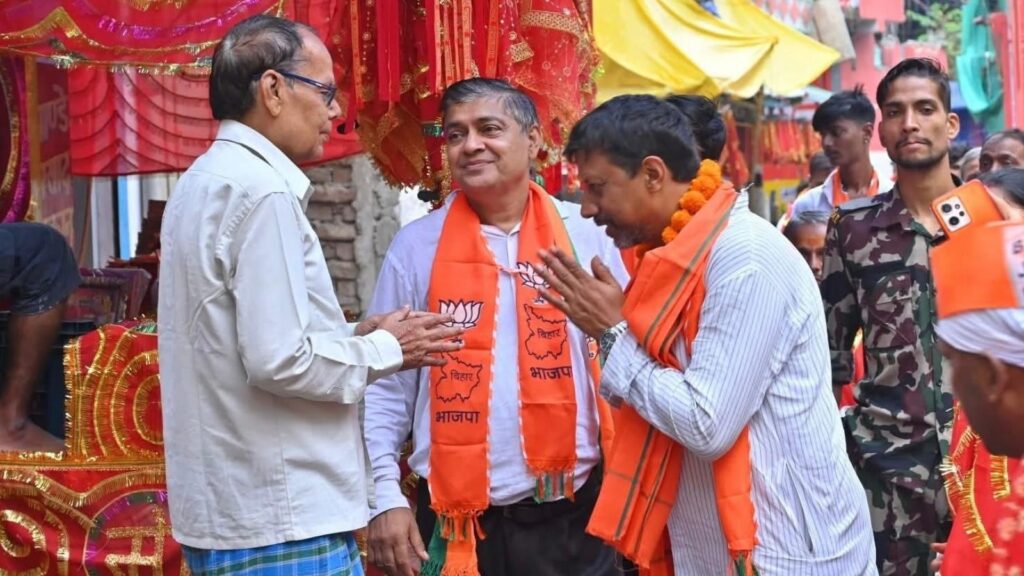In the Patna Sahib Assembly constituency in Bihar’s capital, the ruling BJP has replaced one of its longest-serving legislators, Nand Kishore Yadav, 72, with a new face Ratnesh Kushwaha, a 45-year-old lawyer. A seven-time MLA, Yadav is also the Speaker of the outgoing Assembly.
The Opposition Congress has also fielded a debutant Shashant Shekhar, 35, against Kushwaha. An IIT-IIM graduate, Shekhar, who belongs to the Yadav community, had worked with Jan Suraaj founder Prashant Kishor during his previous stint with the I-PAC (Indian Political Action Committee).
An entirely urban belt, Patna Sahib, named to mark the birthplace of Guru Gobind Singh, has always been a stronghold of the BJP, with Yadav winning it consistently since its formation after the 2008 delimitation. It comes under the Patna Sahib Lok Sabha seat held by senior BJP leader Ravi Shankar Prasad since 2019.
 The RJD candidate
The RJD candidate
The constituency is dominated by the upper-caste Vaishyas with sizeable voters from the OBC communities such as Yadavs, Kurmis and Kushwahas. While Vaishyas are considered as the BJP’s traditional supporters, Yadavs and Muslims are part of the RJD-led Opposition Mahagathbandhan’s core base.
In the 2020 polls, Nand Kishore Yadav had defeated the Congress’s Pravin Singh Kushwaha by 18,300 votes. This time, the Congress has shifted Pravin to Kahalgaon in Bhagalpur, where he is also caught in a “friendly fight” with the RJD’s Rajnish Bharti.
Significantly, in Patna Sahib the BJP has replaced its incumbent Yadav face with a Kushwaha, while the Congress has nominated a Yadav, reflecting the new caste calculations of the two leading contenders.
The Kushwaha (Koeri) community, traditionally associated with agriculture and horticulture, is among the non-Yadav OBCs that the BJP is going all out to consolidate.
“People in Bihar still vote largely along caste lines,” said Subodh Kumar, a trader near Badi Pattan Devi Mandir. “Upper castes usually prefer the BJP, while the backward and smaller castes lean towards Nitish Kumar or Lalu Prasad. Yadav and Muslim voters have stayed with their own representatives, and that’s why Nand Kishore Yadav kept winning.”
While accounting for 3.88 lakh voters and a gender ratio of 921, Patna Sahib has one of the youngest electorates in Patna district. It has 6,939 first-time voters aged 18–19 and around 67,000 voters in the 20–29 age group. Both Shekhar and Kushwaha are seen as symbols of a generational shift in the constituency. The Jan Suraaj has fielded Vinita Mishra, 55.
Outside the Patna Sahib Gurdwara, a 28-year-old man, who did not want to be named, said, “While many people talk about jobs and migration, in the end caste becomes the deciding factor for them too. It is something people carry with them as it defines community and belonging. Even educated voters think about caste before they think about the party.”
Yet, for several locals, development and governance have also become important considerations along with caste for electing their legislator. “Nand Kishore Yadav was respected across communities,” said Akhil Gupta, a small business owner. “People understand who can deliver development. Patna has changed completely under Nitish and Narendra Modi. Earlier, it used to take hours to travel from Danapur to Patna city, as if one is travelling from one city to another.”
For some others, day-to-day issues are more pressing than identity. “This time, work matters more than caste,” said Vishwesh Sharma, a postgraduate student. “Employment, education and infrastructure are the real issues. Patna faces severe waterlogging every time it rains, and even a brief downpour makes it hard to move around. Big flyovers mean little if neighbourhoods remain flooded.”
Rohan Verma, 27, said, “We are young, and we want jobs in Bihar and a better quality of life. Caste may still matter, but it won’t win votes if our streets are flooded and our neighborhoods have garbage piles. Bihar has lagged behind because people have kept voting on caste lines for so many years. Now the generation is changing, we have to rise above caste and vote for development.”
Shekhar represents the Congress’s attempt to project an educated, professional face that could appeal to the city’s middle-class and youth voters.
Some observers feel that while caste remains a decisive factor in Bihar politics, the poll outcome in Patna Sahib could also be influenced by its urban character and relatively high literacy rate. They say the constituency, considered as one of the BJP’s safest urban seats in Bihar, has turned into an important test for the party’s new strategies, noting that Nand Kishore Yadav’s seven consecutive wins indicated his personal popularity as well as the party’s organisational strength.
For the Congress, the contest offers an opportunity to reclaim lost ground in a city where it has been absent for decades.
“Electors are largely educated and pragmatic here,” notes a local resident, adding “They may discuss caste, but their final voting decisions are often shaped by civic concerns like drainage, roads and safety. With two debutants in the fray, it will depend on who is able to convince voters more effectively that they can deliver.”
A retired government employee Rajesh Kumar says, “Caste still matters, but people also want good governance and better living conditions. The poll outcome may depend on the campaigns of the two candidates over real issues.”
Says an auto-rickshaw driver Sunil Rai: “No matter what people say, caste is part of our identity. In Bihar, you can’t escape it. Even if you want to forget it, others will remind you with their behaviour. If someone sees you do not belong to an upper caste, their approach towards you changes.”
The voting in Patna Sahib will take place in the first phase of the Bihar elections on November 6.

